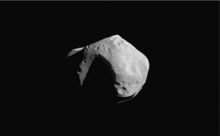
Back ماتيلد 253 Arabic 253 Mathilde (كويكب) ARZ (253) Mathilde Catalan (253) Матильда CE (253) Mathilde German 253 Ματθίλδη Greek 253 Mathilde English 253 Mathilde EO (253) Mathilde Spanish 253 Matilde EU
 NASA image of 253 Mathilde | |
| Discovery | |
|---|---|
| Discovered by | Johann Palisa |
| Discovery date | November 12, 1885 |
| Designations | |
| A915 TN; 1949 OL1 | |
| Main belt | |
| Orbital characteristics[2] | |
| Epoch January 30, 2005 (JD 2453400.5) | |
| Aphelion | 501.334 Gm 3.35121 AU |
| Perihelion | 290.564 Gm 1.94230 AU |
| 395.949 Gm 2.64676 AU | |
| Eccentricity | 0.266157 |
| 1572.787 d
(4.31 yr) | |
Average orbital speed | 17.98 km/s[1] |
| 111.960° | |
| Inclination | 6.738° |
| 179.633° | |
| 157.475° | |
| Physical characteristics | |
| Dimensions | 52.8[2] km (66×48×46 km[3]) |
| Mass | 1.033(±0.044)×1017[4] kg |
Mean density | 1.3[4] g/cm³ |
| 0.0025[5] m/s² | |
| 16.2[6] m/s | |
| 17.406±0.010[7] d (17 d 9 h 45 min) | |
| Albedo | 0.0436[2] |
| Temperature | ~174[8] K |
Spectral type | Cb[2] |
| 10.20[2] | |
253 Mathilde is a main belt asteroid found by Johann Palisa in 1885. It has a fairly elliptical orbit that takes more than four years to circle the Sun. This asteroid has an unusually slow rate of rotation, taking 17.4 days to complete a 360° revolution about its axis. It is a primitive C-type asteroid, which means the surface has lots of carbon; giving it a dark surface that reflects only 4% of the light that falls on it.[9]
This asteroid was visited by the NEAR Shoemaker spacecraft during June 1997, on its way to asteroid 433 Eros. The spacecraft took pictures of one side of the asteroid, finding many big craters that have gouged out depressions in the surface. It is currently the biggest asteroid to be visited by a spacecraft, and the first C-type asteroid to be so explored.
- ↑ For semi-major axis a, orbital period T and eccentricity e, the average orbital speed is given by:
- ↑ 2.0 2.1 2.2 2.3 2.4 Unless otherwise noted, parameters are per: Yeomans, Donald K. (August 29, 2003). "253 Mathilde". JPL Small-Body Database Browser. NASA. Retrieved 2007-08-29.
- ↑ Cite error: The named reference
icarus140was used but no text was provided for refs named (see the help page). - ↑ 4.0 4.1 Cite error: The named reference
Yeomans 1997was used but no text was provided for refs named (see the help page). - ↑ With asteroid mass m, radius r and G equal to the gravitational constant, Newton's law of universal gravitation gives an average surface gravity g of:
- ↑ For surface gravity g and radius r, the escape velocity is:
- ↑ Stefano Mottola; et al. (1995). "The slow rotation of 253 Mathilde". Planetary and Space Science. 43 (12): 1609–1613. Bibcode:1995P&SS...43.1609M. doi:10.1016/0032-0633(95)00127-1. Retrieved 2007-02-04.
- ↑ For asteroid albedo α, semimajor axis a, solar luminosity , Stefan-Boltzmann constant σ and the asteroid's infrared emissivity ε (~0.9), the approximate mean temperature T is given by:
{{cite book}}: CS1 maint: multiple names: authors list (link) - ↑ Cite error: The named reference
flybywas used but no text was provided for refs named (see the help page).
![{\displaystyle {\begin{aligned}v_{o}&={\frac {2\pi a}{T}}\left[1-{\frac {e^{2}}{4}}-{\frac {3e^{4}}{64}}-\dots \right]\\&=18.31\ {\mbox{km/s}}\left[1-0.0177-0.00008-\cdots \right]\\&\approx 17.98\ {\mbox{km/s}}\\\end{aligned}}\!\,}](https://wikimedia.org/api/rest_v1/media/math/render/svg/53d01a9aa752b2d7640a8be18cd4abb402ed8e2c)



